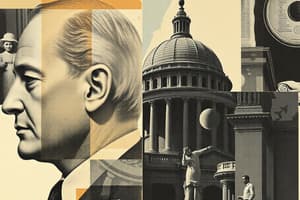Podcast
Questions and Answers
What is a key limitation of fiscal policy due to delays in implementation?
What is a key limitation of fiscal policy due to delays in implementation?
- Time lags (correct)
- Inefficiency in government spending
- Crowding-out effect
- Political considerations
Which of the following can result from increased government borrowing?
Which of the following can result from increased government borrowing?
- Higher employment rates
- Decreased national debt
- Increased interest rates (correct)
- Sustainable economic growth
How can political pressures affect fiscal policy?
How can political pressures affect fiscal policy?
- By enabling immediate implementation of policies
- By stabilizing the economy more effectively
- By influencing the prioritization of policies (correct)
- By improving the efficiency of government spending
What is one of the main goals of maintaining a balanced budget?
What is one of the main goals of maintaining a balanced budget?
Fiscal policy works in conjunction with what other type of policy?
Fiscal policy works in conjunction with what other type of policy?
What is meant by expansionary fiscal policy?
What is meant by expansionary fiscal policy?
How do automatic stabilizers function in fiscal policy?
How do automatic stabilizers function in fiscal policy?
Which of the following is NOT a component of fiscal policy?
Which of the following is NOT a component of fiscal policy?
What is contractionary fiscal policy primarily used for?
What is contractionary fiscal policy primarily used for?
Which statement about transfer payments is correct?
Which statement about transfer payments is correct?
What is one of the primary goals of fiscal policy?
What is one of the primary goals of fiscal policy?
What might be the effect of increasing taxes during an economic downturn?
What might be the effect of increasing taxes during an economic downturn?
Discretionary fiscal policy is characterized by which feature?
Discretionary fiscal policy is characterized by which feature?
Flashcards
Full Employment
Full Employment
A low and sustained unemployment rate indicates a healthy economy, ensuring most who want to work have an opportunity.
Sustainable Economic Growth
Sustainable Economic Growth
Achieving a moderate and consistent rate of economic growth over the long term ensures prosperity and provides an improved standard of living for the population.
Budget Balance/Debt Management
Budget Balance/Debt Management
Maintaining a balanced budget or a manageable level of national debt is important as it reduces risk and potentially mitigates borrowing costs for future generations.
Time Lags in Fiscal Policy
Time Lags in Fiscal Policy
Signup and view all the flashcards
Crowding-Out Effect
Crowding-Out Effect
Signup and view all the flashcards
Fiscal Policy
Fiscal Policy
Signup and view all the flashcards
Components of Fiscal Policy
Components of Fiscal Policy
Signup and view all the flashcards
Aggregate Demand (AD)
Aggregate Demand (AD)
Signup and view all the flashcards
Expansionary Fiscal Policy
Expansionary Fiscal Policy
Signup and view all the flashcards
Contractionary Fiscal Policy
Contractionary Fiscal Policy
Signup and view all the flashcards
Automatic Stabilizers
Automatic Stabilizers
Signup and view all the flashcards
Discretionary Fiscal Policy
Discretionary Fiscal Policy
Signup and view all the flashcards
Price Stability (Inflation Goal)
Price Stability (Inflation Goal)
Signup and view all the flashcards
Study Notes
Economic Policy
- Economic policy encompasses government actions to influence the economy, aiming for stable prices, full employment, and sustainable growth.
- It's categorized into monetary and fiscal policy.
- Monetary policy manages the money supply and credit to affect inflation and interest rates.
- Fiscal policy uses government spending and taxation to control aggregate demand.
Fiscal Policy
- Fiscal policy uses government spending and taxation to influence the economy.
- Key components include government purchases (infrastructure), transfer payments (e.g., social security), and taxes (income, sales).
- These tools influence aggregate demand (total demand for goods and services).
- Expansionary policy increases spending or reduces taxes to boost demand during recessions.
- Contractionary policy decreases spending or raises taxes to cool down an overheating economy.
- Automatic stabilizers are programs that adjust automatically to economic conditions (e.g., unemployment benefits rising with joblessness).
- Discretionary fiscal policy involves deliberate changes to spending or taxes to address specific issues.
Tools of Fiscal Policy
- Government spending directly injects funds into the economy, boosting aggregate demand. This includes investments in public projects, infrastructure, and social programs.
- Taxation influences disposable income, consumer spending, and investment. Higher taxes reduce disposable income, potentially cooling an overheated economy.
- Transfer payments (e.g., unemployment benefits, social security) affect income distribution and aggregate demand. They act as crucial safety nets in downturns.
Goals of Fiscal Policy
- Price stability (low and stable inflation) is crucial for economic predictability, reducing uncertainty for businesses and consumers.
- Full employment (low unemployment) signifies a healthy economy where most who want to work have opportunities.
- Sustainable economic growth ensures long-term prosperity and improved living standards.
- Budget balance/debt management is important to reduce risk and lower borrowing costs for future generations.
Limitations of Fiscal Policy
- Time lags: Changes in fiscal policy don't always take effect immediately, leading to delays and challenges.
- Political considerations: Political pressures can influence policy implementation and effectiveness.
- Crowding-out effect: Increased government borrowing can raise interest rates, reducing private investment.
- Inefficiency in government spending: Government projects can be costly and their effectiveness can be difficult to assess.
Relationship between Economic and Fiscal Policy
- Fiscal policy is part of broader economic policy, working with monetary policy.
- The interaction of these policies directly impacts inflation, employment, and growth.
- Effective economic policy demands careful coordination of monetary and fiscal policy actions.
Studying That Suits You
Use AI to generate personalized quizzes and flashcards to suit your learning preferences.




